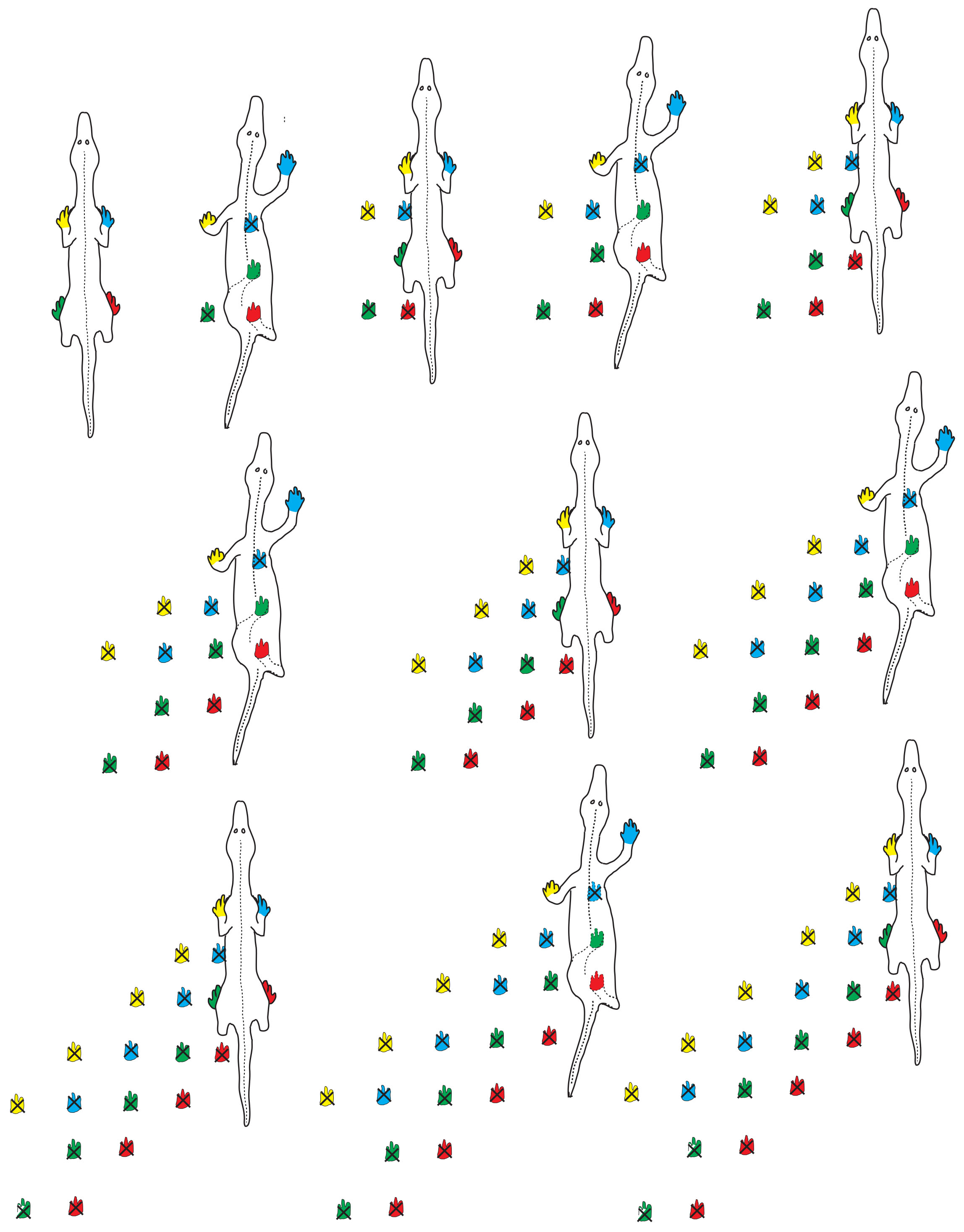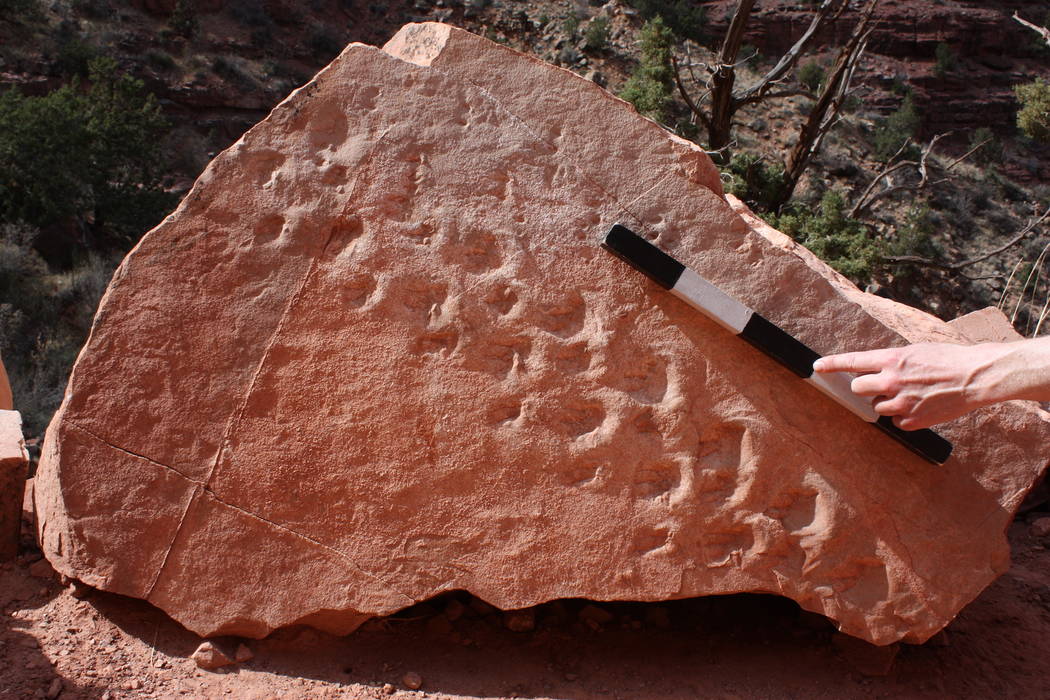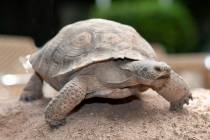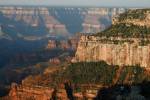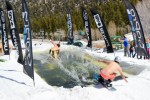UNLV geologist follows ancient footprints into Grand Canyon
Long before the Grand Canyon formed, a primitive reptile the size of a baby alligator skittered sideways across the wet sand of an impossibly ancient coastal plain.
Then came roughly 315 million years of evolution, extinction and other natural forces, which led inevitably to Steve Rowland.
The UNLV geology professor recently identified fossilized tracks from that long-gone reptile on a fallen slab of rock along one of Grand Canyon National Park’s best-known trails.
The 28 footprints run diagonally across a salmon-colored boulder perched on the edge of Bright Angel Trail, less than 3 miles from the South Rim.
“They’re the oldest vertebrate tracks in the Grand Canyon,” Rowland said.
He got his first look at them last year, during a family vacation to the iconic park 280 miles east of Las Vegas.
Rowland said he made a special trip down the trail after hearing about the markings from Allan Krill, an old friend and fellow geologist from Norway who noticed them while hiking in the canyon in the spring of 2016.
“It turned out to be quite extraordinary,” he said.
Near as he can tell from searching the scientific literature, this marks the first time fossils have been documented in this particular rock formation.
Older than the dinosaurs
At the time the tracks were laid down, the land mass that would become North America was closer to the equator and Nevada was covered by an inland sea.
“The supercontinent of Pangea was assembling. It wasn’t formed yet, but it was close,” Rowland said.
The age of dinosaurs was still more than 70 million years away. The Grand Canyon itself wouldn’t be carved for at least another 245 million years.
Scientists probably never will know exactly what kind of animal left the tracks, but Rowland pictures a lizard-like creature about 2 feet in length, similar in size to a Galapagos iguana.
Rowland presented his findings last month during the international Society of Vertebrate Paleontology’s annual meeting in Albuquerque, New Mexico.
He hopes to submit a scientific paper on the discovery in January, once he homes in on “the global significance” of what he found.
In the meantime, he said, he has been in discussions with park officials about what to do with the rock itself, which measures about 3 feet long and 2½ feet thick and probably weighs over 1,000 pounds.
Rowland said he would like to see them helicopter it out of the canyon and put it in a museum.
“More than likely that’s not going to happen,” said ranger Kari Cobb, spokeswoman for the park.
Removing the rock and putting it on display somewhere doesn’t really fit with the Park Service’s mission to preserve resources in their natural state, Cobb said. “But we may put up an interpretive sign telling people what they’re looking at.”
Sideways walk into history
Rowland said the footprints also are unusual because of the “peculiar gait” of the animal that left them. Based on the orientation of the toes and the direction of the tracks, it appears the creature was moving diagonally, like a line dancer sliding sideways across a dance floor.
Rowland has a number of possible explanations for this. Maybe the animal was walking along a steep slope or fighting a strong wind. Maybe another member of its species was nearby, and its movements were part of a territorial fight or a mating dance.
How the fossilized footprints ended up where they are now is an interesting story in its own right.
Rowland said the rock slab containing the hidden tracks tumbled onto Bright Angel Trail about three years ago, when part of a cliff collapsed. As the rock fell, it split in just the right way to expose the footprints.
As the park’s maintenance crew cleared away the debris, one of the workers noticed the strange markings and decided to place the rock along the walking path so hikers could see it. Rowland’s friend from Norway happened to be one those hikers.
“It’s this strange sequence of unlikely coincidences,” Rowland said.
But in a national park as vast and as rugged as the Grand Canyon, Cobb said, she isn’t surprised by a surprising find like this one, even on such a popular trail.
“There’s so much that’s waiting to be discovered,” she said. “I think that’s just one of the things that makes the Grand Canyon such an incredible place.”
A previous version of this article misstated the location of the fossilized prints.
Contact Henry Brean at hbrean@reviewjournal.com or 702-383-0350. Follow @RefriedBrean on Twitter.
